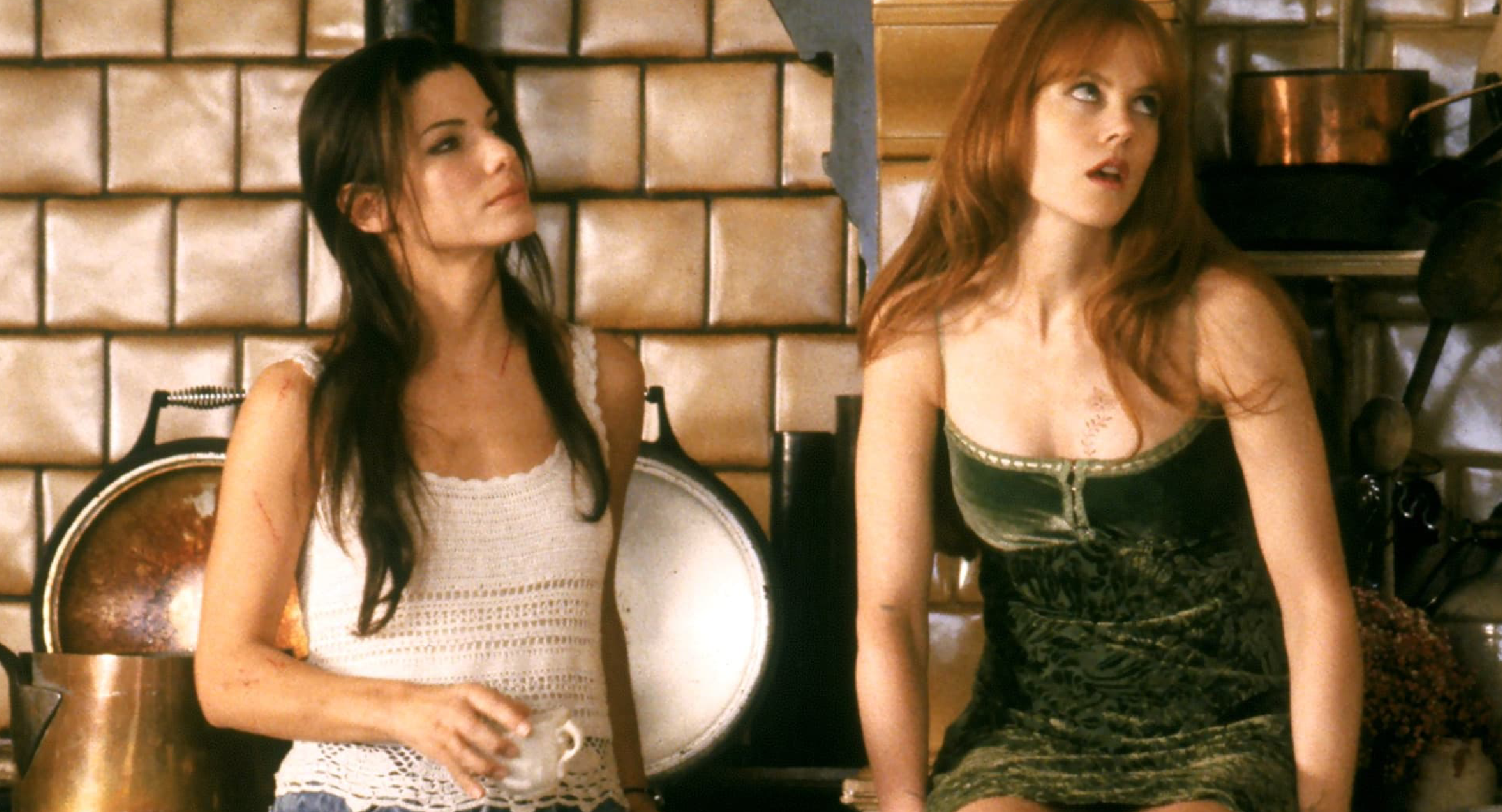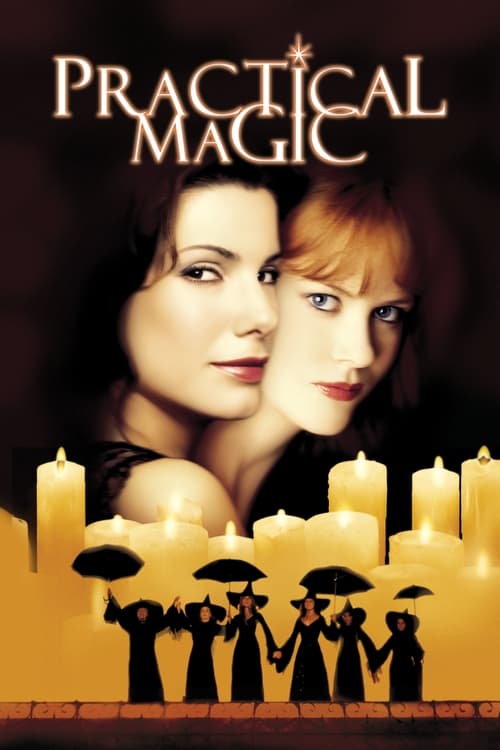Practical Magic – Film Review
Published September 1, 2024

Griffin Dunne‘s Practical Magic was supposed to be a charming blend of romance, fantasy, and dark comedy. Adapted from Alice Hoffman‘s novel, the film had all the elements to become a cult classic: a star-studded cast, a compelling premise centered around a family of witches, and a whimsical yet haunting aesthetic. However, despite these promising ingredients, Practical Magic ultimately fails to deliver, leaving viewers with a muddled narrative, underdeveloped characters, and a tonal inconsistency that renders it more confusing than enchanting.
The film revolves around the Owens sisters, Sally (Sandra Bullock) and Gillian (Nicole Kidman), who come from a long line of witches cursed in love. After their parents’ deaths, the sisters are raised by their aunts, Jet (Dianne Wiest) and Frances (Stockard Channing), in a quaint, small-town mansion. The story attempts to weave together various elements: the sisters’ struggles with their supernatural abilities, the romantic entanglements complicated by the family curse, and a murder mystery that emerges halfway through the film.
At its core, Practical Magic is supposed to be a tale of sisterhood, love, and overcoming personal demons. However, the plot is so disjointed that it’s hard to discern what the film is really about. The first half of the movie leans heavily into romantic comedy territory, focusing on Sally’s tragic love life and Gillian’s wild adventures. But when the sisters accidentally kill Gillian’s abusive boyfriend, Jimmy (Goran Visnjic), the film takes a sharp turn into a supernatural thriller, complete with ghostly apparitions and possession. This sudden shift is jarring and feels like an entirely different movie, creating a confusing and unsatisfying viewing experience.
The film’s pacing is another major issue. Key plot points are rushed, such as Sally’s whirlwind romance with her first husband and his subsequent death, which is glossed over so quickly that it barely registers emotionally. Meanwhile, other scenes drag on unnecessarily, like the prolonged and awkward séance intended to banish Jimmy’s spirit. These pacing issues contribute to the film’s overall lack of cohesion, making it difficult for viewers to stay engaged.
With a cast as talented as Sandra Bullock, Nicole Kidman, Dianne Wiest, and Stockard Channing, one would expect Practical Magic to shine through its performances. Unfortunately, the characters are so underdeveloped that even these seasoned actors struggle to bring them to life.
Sandra Bullock’s Sally is the more grounded of the two sisters, meant to be the emotional core of the film. However, her character is disappointingly one-dimensional, defined almost entirely by her fear of love and her desire for normalcy. Bullock does her best with the material, but the script gives her little to work with. Sally’s emotional journey is supposed to be central to the story, but it feels shallow and unconvincing, largely because the film fails to delve deeply into her internal struggles.
Nicole Kidman’s Gillian, on the other hand, is the free-spirited, rebellious sister who embraces her powers and lives life on her own terms. Yet, despite her wild lifestyle, Gillian comes across as a caricature rather than a fully realized character. Her backstory is barely explored, leaving viewers with little understanding of why she behaves the way she does. Kidman’s performance is lively and charismatic, but it’s not enough to compensate for the script’s shortcomings.
The supporting characters, including the aunts and the townswomen, are similarly underutilized. Dianne Wiest and Stockard Channing bring a delightful eccentricity to their roles as the Owens sisters’ aunts, but they are relegated to the background for much of the film. Their roles as mentors and guardians are barely touched upon, and the bond between them and their nieces is never fully developed. This is a significant missed opportunity, as the aunts’ relationship with the sisters could have added much-needed depth and heart to the story.
The male characters fare even worse. Aidan Quinn‘s Gary Hallet, a detective investigating Jimmy’s disappearance, is introduced late in the film as a potential love interest for Sally. However, his character is so thinly sketched that their romance feels forced and unearned. Jimmy, the film’s antagonist, is little more than a plot device, a one-dimensional villain whose motivations are never explored. His transformation into a ghostly figure is meant to add tension to the story, but it only serves to highlight the film’s lack of direction.
One of the biggest problems with Practical Magic is its tonal inconsistency. The film struggles to balance its various genres—romance, comedy, drama, and horror—resulting in a disjointed viewing experience. The light-hearted, whimsical moments often clash with the darker, more sinister elements, creating a sense of confusion about what the film is trying to achieve.
For instance, the scenes depicting the Owens sisters’ childhood are whimsical and magical, reminiscent of a fairy tale. Yet, these moments are abruptly contrasted with darker scenes, such as the abusive relationship between Gillian and Jimmy, which is handled in a way that feels disturbingly out of place in what is otherwise a light-hearted movie. The film’s attempt to mix romance with horror leads to some bizarre tonal shifts, like the aforementioned séance scene, which awkwardly oscillates between suspense and unintentional comedy.
This lack of a consistent tone undermines the film’s emotional impact. The audience is never quite sure whether they are supposed to be laughing, crying, or feeling scared, making it difficult to connect with the story on any meaningful level. As a result, the film fails to deliver on any of the genres it attempts to tackle, leaving viewers unsatisfied.
Visually, Practical Magic has its moments. The Owens’ family mansion, with its gothic architecture and lush gardens, is beautifully realized, providing the perfect backdrop for a story about witches. The film’s use of color, particularly the vibrant reds and earthy tones, adds to its otherworldly atmosphere. However, these visual elements are not enough to save the film from its narrative shortcomings.
The special effects, particularly during the film’s climactic scenes, are dated and unconvincing. The ghostly manifestations of Jimmy’s spirit are more laughable than frightening, undermining the intended suspense. Similarly, the magical elements, such as the sisters’ spell-casting, are portrayed in a way that feels cheesy rather than enchanting, further detracting from the film’s credibility.
Practical Magic is a film that had the potential to be something truly special, but it falls short on almost every front. Its disjointed plot, underdeveloped characters, and tonal inconsistencies make it a frustrating and unsatisfying watch. Despite the efforts of its talented cast, the film fails to weave its various elements into a cohesive and compelling story. What could have been a charming and magical tale of love and sisterhood instead turns into a muddled mess that is neither practical nor magical. For those looking for a captivating story about witches, there are far better options out there.
